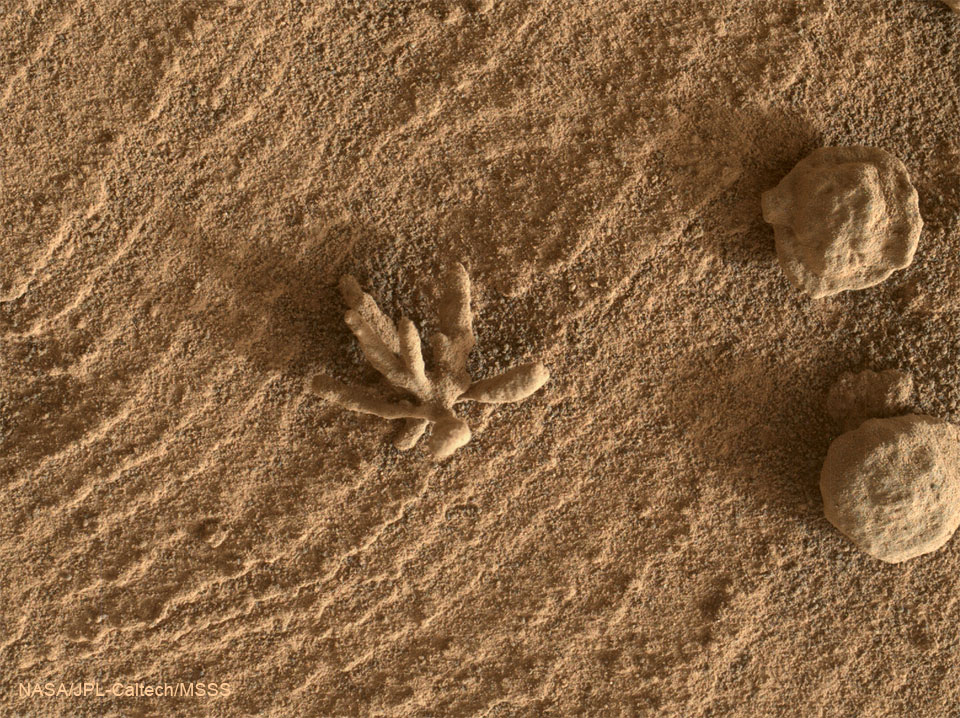09. March 2022
火星花 - 火星面頂 ê 石頭

探索宇宙1!逐工會揀一幅無仝款 ê 影像抑是相片,𤆬你熟似咱這个迷人 ê 宇宙,閣有專業天文學者2為你3解說4。
- 原始文章:A Flower-Shaped Rock on Mars
- 影像來源:NASA, JPL-Caltech, MSSS
- 台文翻譯:An-Li Tsai (NCU)
[漢羅] 火星花 - 火星面頂 ê 石頭
這是目前為止火星面頂上奇怪 ê 石頭。 這粒石頭是比一箍銀閣較細,毋閣伊面頂有幾若支手,予伊看起來敢若是一蕊花。 若是講這粒石頭 真正是古早時代 火星花 ê 化石,按呢這 to̍h 是一个大發現矣! 毋閣現此時,逐家 較愛用 較普通 ê 講法,來解說這个無四常 ê 結構。 這馬有一个理論是講,這粒石頭是一款 結規丸 ê 現象,是 tī 岩石必開 ê 閬縫內底,產生 由水 沉積 ê 礦物。 這寡 結規丸 ê 結構 to̍h 是會當 kā 物質櫼做一丸。 伊會比邊仔 ê 石頭較𠕇、較實密,就算是邊仔 ê 石頭去予 侵蝕 了後,伊猶有法度留落來。 這个花 ê 結構嘛有可能是 一款 晶簇 結構。 這粒 細粒石頭 叫做 Blackthorn Salt,kah 進前 去予 翕著 ê 彼粒 火星 石卵 有 相-siâng。 這張相片 是 好奇號探測車 二月底彼陣 tī 火星 翕 ê。 Tī 火星 ê 這款石頭 實在是足趣味 ê。 科學家會繼續研究 ùi 火星提著 ê 這款資料 kah 影像。
[POJ] Hóe-chhiⁿ-hoe - Hóe-chhiⁿ bīn-téng ê chio̍h-thâu
Che sī bo̍k-chêng ûi-chí Hóe-chhiⁿ bīn-téng siōng kî-koài ê chio̍h-thâu. Chit-lia̍p chio̍h-thâu sī pí chi̍t kho͘ gîn koh khah sè, m̄-koh i bīn-téng ū kúi-ā ki chhiú, hō͘ i khòaⁿ--khí-lâi ká-ná sī chi̍t lúi hoe. Nā-sī kóng chit-lia̍p chio̍h-thâu chin-chiàⁿ sī kó͘-chá sî-tāi Hóe-chhiⁿ-hoe ê hòa-chio̍h, án-ne che to̍h sī chi̍t-ê tōa hoat-hiān ah! M̄-koh hiān-chú-sî, ta̍k-ke khah ài iōng khah phó͘-phiàn ê kóng-hoat, lâi kái-soeh chit-ê bô sù-siông ê kiat-kò͘. Chit-má ū chi̍t-ê lí-lūn sī kóng, chit-lia̍p chio̍h-thâu sī chi̍t-khoán kiat-kui-oân ê hiān-siōng, sī tī giâm-chio̍h pit-khui ê làng-phāng lāi-té, sán-seng iû chúi tîm-chek ê khòng-bu̍t. Chit-kóa kiat-kui-oân ê kiat-kò͘ to̍h sī ē-tàng kā bu̍t-chit chiⁿ chò chi̍t-oân. I ē pí piⁿ-á ê chio̍h-thâu khah tēng, khah cha̍t-ba̍t, tō-sǹg-sī piⁿ-á ê chio̍h-thâu khì hō͘ chhim-sit liáu-āu, i iáu-ū hoat-tō͘ lâu--lo̍h-lâi. Chit-ê hoa ê kiat-kò͘ mā ū khó-lêng sī chi̍t-khoán chiⁿ-chhok kiat-kò͘. Chit-lia̍p sè-lia̍p chio̍h-thâu kiò chò Blackthorn Salt, kah chìn-chêng khì hō͘ hip-tio̍h ê hit-lia̍p Hóe-chhiⁿ chio̍h-nn̄g ū sio-siâng. Chit-tiuⁿ siòng-phìⁿ sī Hòⁿ-kî-hō thàm-chhek-chhia jī goe̍h hit-chūn tī Hóe-chhiⁿ hip ê. Tī Hóe-chhiⁿ ê chit-khoán chio̍h-thâu si̍t-chāi sī chiok chhù-bī ê. Kho-ha̍k-ka ē kè-sio̍k gián-kiù ùi Hóe-chhiⁿ the̍h-tio̍h ê chit-khoán chu-liāu kah iáⁿ-siōng.
[KIP] Hué-tshinn-hue - Hué-tshinn bīn-tíng ê tsio̍h-thâu
Tse sī bo̍k-tsîng uî-tsí Hué-tshinn bīn-tíng siōng kî-kuài ê tsio̍h-thâu. Tsit-lia̍p tsio̍h-thâu sī pí tsi̍t khoo gîn koh khah sè, m̄-koh i bīn-tíng ū kuí-ā ki tshiú, hōo i khuànn--khí-lâi ká-ná sī tsi̍t luí hue. Nā-sī kóng tsit-lia̍p tsio̍h-thâu tsin-tsiànn sī kóo-tsá sî-tāi Hué-tshinn-hue ê huà-tsio̍h, án-ne tse to̍h sī tsi̍t-ê tuā huat-hiān ah! M̄-koh hiān-tsú-sî, ta̍k-ke khah ài iōng khah phóo-phiàn ê kóng-huat, lâi kái-sueh tsit-ê bô sù-siông ê kiat-kòo. Tsit-má ū tsi̍t-ê lí-lūn sī kóng, tsit-lia̍p tsio̍h-thâu sī tsi̍t-khuán kiat-kui-uân ê hiān-siōng, sī tī giâm-tsio̍h pit-khui ê làng-phāng lāi-té, sán-sing iû tsuí tîm-tsik ê khòng-bu̍t. Tsit-kuá kiat-kui-uân ê kiat-kòo to̍h sī ē-tàng kā bu̍t-tsit tsinn tsò tsi̍t-uân. I ē pí pinn-á ê tsio̍h-thâu khah tīng, khah tsa̍t-ba̍t, tō-sǹg-sī pinn-á ê tsio̍h-thâu khì hōo tshim-sit liáu-āu, i iáu-ū huat-tōo lâu--lo̍h-lâi. Tsit-ê hua ê kiat-kòo mā ū khó-lîng sī tsi̍t-khuán tsinn-tshok kiat-kòo. Tsit-lia̍p sè-lia̍p tsio̍h-thâu kiò tsò Blackthorn Salt, kah tsìn-tsîng khì hōo hip-tio̍h ê hit-lia̍p Hué-tshinn tsio̍h-nn̄g ū sio-siâng. Tsit-tiunn siòng-phìnn sī Hònn-kî-hō thàm-tshik-tshia jī gue̍h hit-tsūn tī Hué-tshinn hip ê. Tī Hué-tshinn ê tsit-khuán tsio̍h-thâu si̍t-tsāi sī tsiok tshù-bī ê. Kho-ha̍k-ka ē kè-sio̍k gián-kiù uì Hué-tshinn the̍h-tio̍h ê tsit-khuán tsu-liāu kah iánn-siōng.
[English] A Flower-Shaped Rock on Mars
It is one of the more unusual rocks yet found on Mars. Smaller than a penny, the rock has several appendages that make it look, to some, like a flower. Although it would be a major discovery if the rock was truly a fossilized ancient Martian flower, there are less spectacular -- and currently preferred -- explanations for its unusual structure. One theory that has emerged is that the rock is a type of concretion created by minerals deposited by water in cracks or divisions in existing rock. These concretions can be compacted together, can be harder and denser than surrounding rock, and can remain even after the surrounding rock erodes away. The flower structure may also be caused by crystal clusters. The small rock, named Blackthorn Salt, has similarities to previously imaged Martian pebbles. The featured image was taken by the Curiosity rover on Mars in late February. Scientists will continue to study data and images taken of this -- and similar -- surprising Martian rocks.
詞彙學習
| 漢羅 | POJ | KIP | 華語 | English |
|---|---|---|---|---|
| 結規丸 | kiat kui-oân | kiat kui-uân | 結核 | concretion |
| 櫼 | chiⁿ | tsinn | 壓緊 | compact |
| 𠕇 | tēng | tīng | 硬 | hard |
| 晶簇 | chiⁿ-chhok | tsinn-tshok | 晶簇 | crystal clusters |
| 石卵 | chio̍h-nn̄g | tsio̍h-nn̄g | 鵝卵石 | pebbles |
| 好奇號探測車 | Hòⁿ-kî-hō thàm-chhek-chhia | Hònn-kî-hō thàm-tshik-tshia | 好奇號探測車 | the Curiosity rover |
| 侵蝕 | chhim-sit | tshim-sit | 侵蝕 | erode |
| 沉積 | tîm-chek | tîm-tsik | 沉積 | deposit |